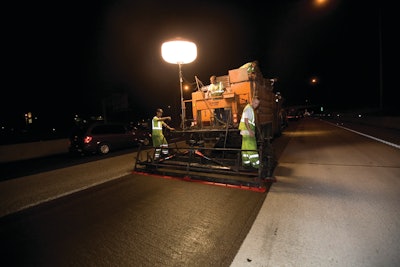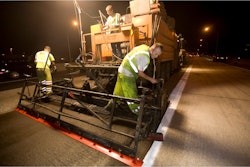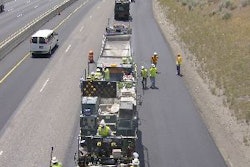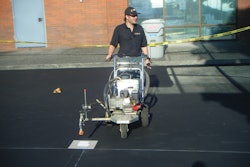
In St. Louis, MO, the four-year-old Novachip surfaces on I-70 and I-270 was beginning to polish, creating safety skid issues. To rehabilitate the two highways, the project included 38 separate pay items including milling, patching, HMAC overlays, concrete patching, rumble strips, traffic control and striping items. It also included 100 lane miles of urban highway micro surfacing.
"Micro-Surfacing Inc. has been doing micro surfacing for about 20 years," says Tom Ritschel, president of Micro-Surfacing Inc. (MSI), St. Louis. "We have also done a lot of night work. We have also worked in St. Louis before, including expressway work at night, but no other jobs near this large.
"Cost and speed of application were major reasons why micro surfacing was chosen," he explains.
A versatile tool in the road maintenance arsenal, micro surfacing is a polymer modified, cold mixed, quick setting, asphalt resurfacing material that can remedy a broad range of problems on today's highways. It's designed to be applied in a semi-liquid condition with a specialized mixing and paving machine. By design it chemically changes from a semi-liquid material to a dense cold mix material that is able to carry normal traffic within one hour after application.
The micro surfacing work specification for the I-70/I-270 project was from the Missouri Standard Specification book section 413.1. It called for a two-pass, 30-pound total application of asphalt emulsion micro surfacing on 746,937 square yards of roadway. For friction purposes, an air-cooled blast furnace slag aggregate was used. The micro surfacing on this project was mixed and applied by a Bergkamp M-1 continuous paver.
The prep for micro surfacing included 11,000 tons of HMAC on ramp overlays and some mainline patching, miscellaneous milling and cement repairs, and removal/replacement of existing pavement markings and inlaid markers.
Safety is paramount
The I-70/I-270 project was a traffic safety project to improve pavement surface friction on both interstate highways in St. Louis, says Ritschel. In addition to improving pavement surface, the project included improving many ramps with HMAC overlays in the same contract.
The biggest challenge in this project was coordinating the work crews doing patching, micro surfacing, traffic control and striping so that each crew could get in a full night’s work and still have the roadway opened and re-striped by 5 a.m. each morning.
This project is the largest interstate micro surfacing project ever done in the four state area of Missouri, Illinois, Indiana and Iowa, says Ritschel. Traffic volumes on the sections micro surfaced varied from 100,000 to 140,000 vehicles per day.
Over 70 nights, one or more crews worked on the project. There were no accidents or work-related injuries.
Restrictions & challenges
The job was bid in May 2011 with patching work beginning June 23. Micro crew work began on July 11 and was completed on September 15. HMA work was completed October 26. All work needed to be complete by November 1 or a penalty of $21,625 per day would be implemented.
The project had work hour restrictions of 8 p.m. to 5 a.m. each day, with a $1,000 penalty for every 15-minute delay. When the St. Louis Cardinals played night games at Busch Stadium, crews had lane closure restrictions that started 45 minutes before and after the game.
Summer temperatures were also a challenge during the project. Air temperatures reached 100 degrees F with pavement temperatures near 120 degrees F.
"The temperatures were tough on the crew; plenty of water was needed on the jobsite," says Ritschel. "But the crew was grateful that the work was not during the daytime hours. The emulsion in the mix was adjusted by the manufacturer, Bi-State Emulsion, to mix and set properly in warm temperatures. Here again, daytime conditions would have been more difficult."
It takes a village
Another key challenge was scheduling and coordinating night-time traffic control in a downtown urban environment. In total there are 86 separate on/off ramps within the limits of the project. Consecutive ramps were not allowed to be closed at the same time. All signs and traffic control equipment were required to be off the roadway by 5 a.m.
"Project manager Dave Miller spent almost all of his time figuring out what crews could work where on a given night," says Ritschel. "We knew how much time was needed to put down new stripes, so other work stopped to allow for striping, usually about 3 a.m.
"Like any plan, you start with a framework, build in details, see how it starts, then make adjustments every day," he continues.
Some examples of adjustments MSI had to deal with included the St. Louis Cardinals playing a few extra night baseball games than scheduled on their way to the championship and a visit from the President of the United States.
"One night President Obama came to town," says Ritschel. "We didn't work and had all signage removed for him. Our goal was to finish micro by Labor Day. We just missed due to a rain."
With all its challenges, the project was still completed on time and under budget.
"This project was very challenging because of the amount of work, the high-traffic volumes on these roads, and the time of year the project was awarded," says Dave Bauer, resident engineer with the Missouri Department of Transportation (MoDOT). "I have received positive comments from both MoDOT employees as well as from the traveling public about the final appearance of the roadway. Many believed that the project overlaid the roadway, which is a much more costly application than micro surfacing.
"In these hard economic times when money is in short supply to maintain our road and bridges, a quality micro surfacing application is a way to lengthen the life of our pavements in a cost-effective manner," he concludes.




















